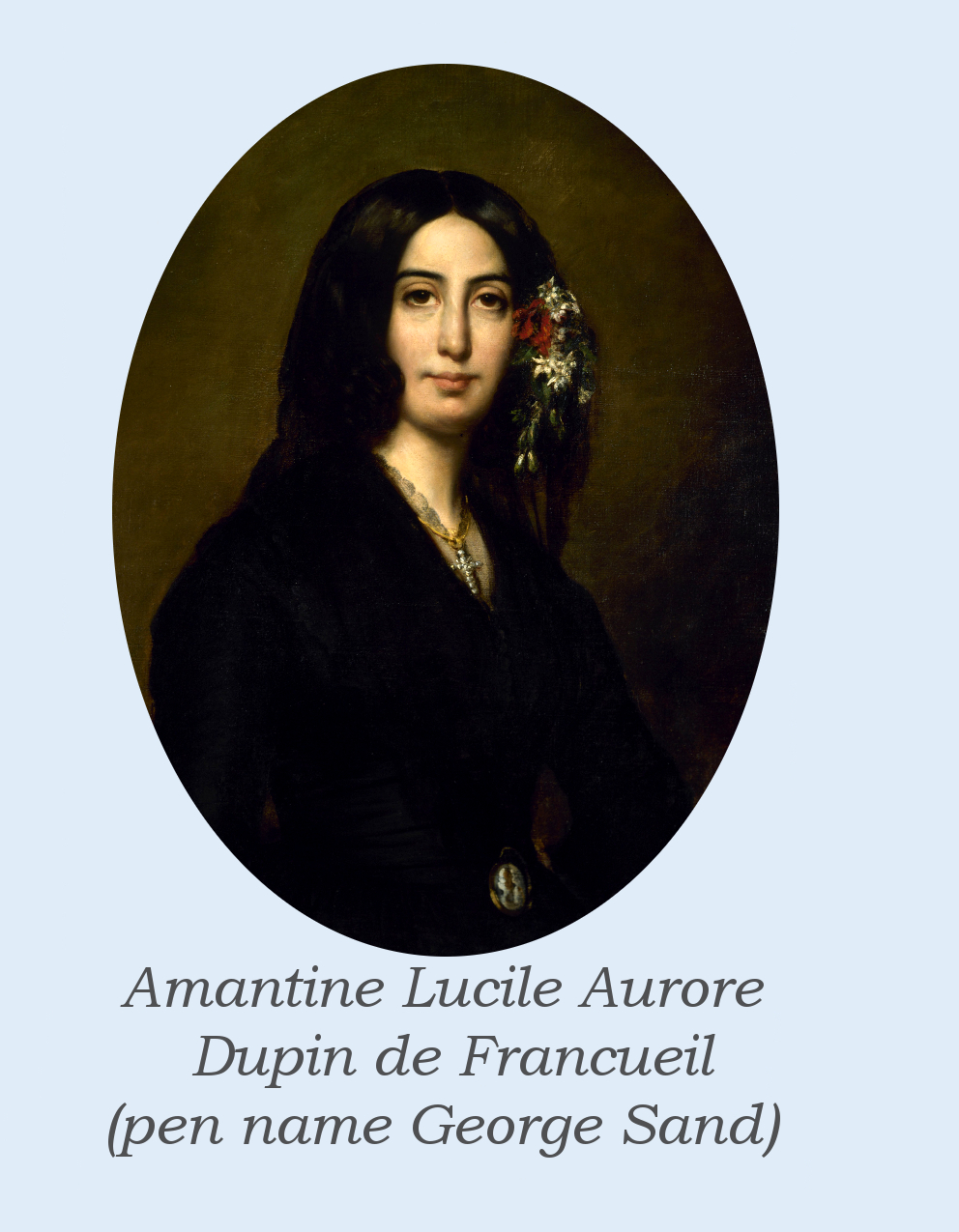
George Sand
 Biography
BiographyAmantine Lucile Aurore Dupin de Francueil (July 1, 1804–June 8, 1876), best known by her pen name George Sand, was a French novelist, memoirist, and journalist. One of the most popular writers in Europe in her lifetime, more renowned than both Victor Hugo and Honoré de Balzac in England in the 1830s and 1840s, Sand is recognised as one of the most notable writers of the European Romantic era, with more than 70 novels to her credit and 50 volumes of various works including novels, tales, plays and political texts. Like her great-grandmother, Louise Dupin, whom she admired, George Sand stood up for women, advocated passion, castigated marriage, and fought against the prejudices of society.
Born in Paris to Maurice Dupin de Francueil and Sophie-Victoire Delaborde, she was the paternal great-granddaughter of the Marshal of France Maurice de Saxe (1696–1750), and on her mother's side, her grandfather was Antoine Delaborde, master paulmier and master birder. Thus she had a dual ancestry, both popular and aristocratic, which marked her deeply, two diametrically opposed social origins which explain her personality and political commitment. Known to her friends and family as “Aurore,” she was raised for much of her childhood by her grandmother Marie-Aurore de Saxe, Madame Amantine Aurore Lucile Dupin de Francueil, at her grandmother’s house in the village of Nohant, in the French province of Berry. She inherited the house in 1821 when her grandmother died and used the setting in many of her novels.
Sand was one of many notable 19th-century women who chose to wear male attire in public. In 1800 the police issued an order requiring women to apply for a permit in order to wear male clothing. Some women applied for health, occupational, or recreational reasons (e.g., horseback riding), but many women chose to wear pants and other traditional male attire in public without receiving a permit. Sand was one of those women who wore men’s clothing without a permit, justifying it as being less expensive and far sturdier than the typical dress of a noblewoman at the time. In addition to being comfortable, Sand’s male attire enabled her to circulate more freely in Paris than most of her female contemporaries and gave her increased access to venues that barred women. Also scandalous was Sand’s smoking tobacco in public; neither peerage nor gentry had yet sanctioned the free indulgence of women in such a habit, especially in public, although Franz Liszt’s paramour Marie d’Agoult affected this as well, smoking large cigars. While some contemporaries were critical of her comportment, many people accepted her behaviour—until they became shocked with the subversive tone of her novels. Those who found her writing admirable were not bothered by her ambiguous or rebellious public behaviour. Victor Hugo commented, “George Sand cannot determine whether she is male or female. I entertain a high regard for all my colleagues, but it is not my place to decide whether she is my sister or my brother.” In 1831, at the age of twenty-seven, she chose the pseudonym George Sand, a feminine of the first name Georges with “Sand” added, a diminutive of “Sandeau,” the name of Jules, her lover at the time. This decision came from a desire to sow confusion about her identity and thus increase her chances of being published in a then resolutely male publishing world.
In 1822, at the age of eighteen, Sand married François Casimir Dudevant, an out-of-wedlock son of Baron Jean-François Dudevant. She and Dudevant had two children: Maurice and Solange (1828–1899). In 1825 she had an intense but perhaps platonic affair with the young lawyer Aurélien de Sèze. In early 1831 she left her husband and entered upon a four- or five-year period of “romantic rebellion.” In 1835 she was legally separated from Dudevant and took custody of their children. Sand had romantic affairs with the novelist Jules Sandeau, the writer Prosper Mérimée, the dramatist Alfred de Musset, Louis-Chrysostome Michel, the actor Pierre-François Bocage, the writer Charles Didier, the novelist Félicien Mallefille, the politician Louis Blanc, and a long-lasting one with the composer Frédéric Chopin. Later in her life she corresponded with Gustave Flaubert, and despite their differences in temperament and aesthetic preference they eventually became close friends. She also engaged in an intimate romantic relationship with actress Marie Dorval. The two met in January 1833 after Sand wrote Dorvall a letter of appreciation following one of her performances. Her relationship with Chopin lasted for years (1838–1847) but was damaged when she used the tuberculosis-sickened composer as a model for the sickly Eastern European prince Karol in her novel Lucrezia Floriani. Chopin and Sand separated two years before his death. In 1848 he returned to Paris from a tour of the United Kingdom and died in 1849. George Sand was notably absent from his funeral.
Bibliography (wildly incomplete)
The Last Aldini: A Love Story (c. 1845)
Other links
Britannica
Encyclopedia of World Biography
Wikipedia